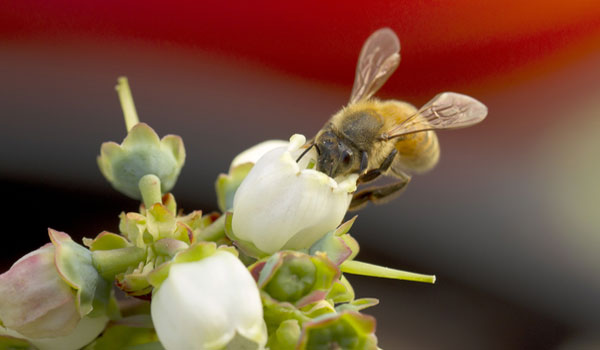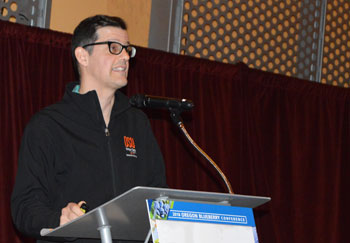
POLLINATOR PROFESSOR BREAKS DOWN LAST YEAR'S SPOTTY FRUIT SET
The reasons behind the poor fruit set some growers experienced in blueberries last year can be boiled down to four elements, according to Oregon State University Extension Pollinator Health Professor Andony Melathopoulos:
- Pollen is not moved enough;
- Pollen is not moved fast enough;
- Pollen is incompatible;
- The wrong bee is involved.
Melathopoulus said several factors can negatively influence pollen movement, including insufficient bee numbers. He said growers should shoot for three hives of six frames each per acre and monitor to ensure the health of bees.
“Checking out colony strength is something growers should do,” he said. Look for four to eight bees per bush during warmest parts of the day, he said.
 |
OSU Extension Pollinator Health Professor Andony Melathopoulos at the Oregon Blueberry Conference said several factors can influence fruit set in blueberries. |
As for timing, he said colonies should be brought in to blueberry fields between 10 and 25 percent bloom. Bees brought in prior to 10 percent bloom will go elsewhere. Bees brought in too late are going to result in a lot of flowers not getting pollinated. Often the timing of hive placement can be influenced by outside factors, however, including whether beekeepers conclude their work in California almonds in time to service blueberries; and, when beekeepers arrive back in Oregon, they can choose between cherries and blueberries, and cherries are easier on bees, he said.
“So, you’ve got two problems. One is hoping beekeepers get back from almonds on time and, obviously, the almonds are going to drive the beekeepers’ decision making,” he said. Beekeepers receive an average of $185 an acre for work in almonds, versus about $55 an acre for their services in cherries and blueberries. “And the second problem is whether beekeepers will go to blueberries or cherries.”
Another factor that can influence pollination is cultivar preference, Melathopoulus said. Bees prefer cultivars with wide flower openings, such as Duke, over cultivars with narrow openings, such as Liberty.
“The cultivar flower plays a big role in terms of whether bees are going to be effective. You may have to think of other strategies when you have difficult-to-pollinate cultivars,” he said.
“Higher stocking rates on fields, especially those with cultivars that are harder to pollinate, may just by brute force get that pollen down,” he said.
As for the rapidity of pollen transfer, Melathopoulus said bees typically have four days to complete the transfer. “If it is hot, that is going to go quicker. If it is cool, that will last longer,” he said. “But generally, four days is what you have. After that, anything that is not pollinated, you are going to have a problem.”
An accumulation of cool days during pollination also can play a factor, Melathopoulus said, particularly when relying on honeybees.
“One area where bumblebees play a big role is under conditions that are poor, particularly when it is cold,” he said. “Bumblebee visitations are the same on good days as bad days.”
Melathopoulus noted that fruit set tends to be fairly high when conditions are poor for pollination, such as when conditions are cold or rainy, but berry size tends to decrease.
“This may explain last year,” he said. “You got some fruit set, but the berry weight was very low.”
|
